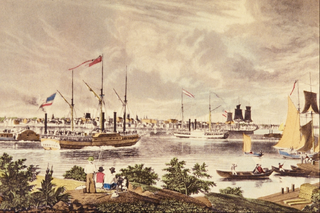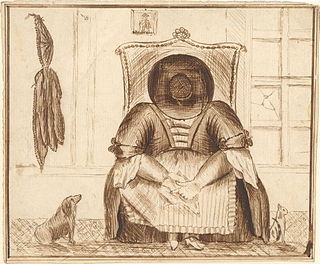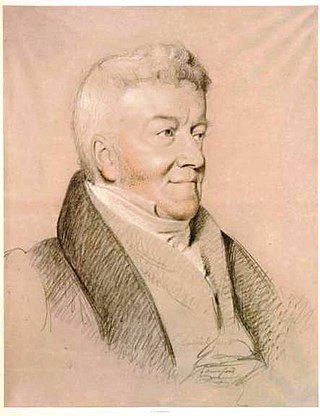

John James Barralet (c. 1747 - January 16, 1815) was an Irish artist who spent the later part of his career in the United States.


John James Barralet (c. 1747 - January 16, 1815) was an Irish artist who spent the later part of his career in the United States.
John James Barralet was born in 1747 to a French Family in Dublin. [1] Barralet had joined two classes at The Dublin Society of Drawing schools aged seventeen and he was awarded premium in 1764. [2] [1] He was educated by James Mannin and he was awarded prizes for both 'Drawing of human figures and heads' and 'Inventions in designs and patterns'. [2] [3] He specialised in landscapes, producing prosaic works. He was lauded for his figures which were said to give a lively immediacy to his watercolours. [1] His brother John Melchior Barralet was a teacher in London in The Royal Academy in 1770. [4] He also had a brother Joseph Barralet. [3]
In June 1791, his drawings helped Benjamin Simpson win a competition to a design the gardens in Merrion Square. [5]
He exhibited three landscapes at the Royal Academy in 1770, and occasionally exhibited in succeeding years. He was employed in illustrating books on Irish Antiquities.
In 1795 he emigrated to America, settling in Philadelphia, where he died in 1815. [6]
The Havell family of Reading, Berkshire, England, included a number of notable engravers, etchers and painters, as well as writers, publishers, educators, and musicians. In particular, members of this family were among the foremost practitioners of aquatint; and had a long association with Indian art and culture. The family first came to notice through the brothers Luke Havell and Robert Havell the Elder ; along with their nephew Daniel Havell.
Harriet Gouldsmith was an English landscape painter and etcher.

John Laporte was an English landscape painter and etcher, who worked in and around London, England.

William James Bennett (1787−1844), was a British-born painter and engraver, active in the United States from 1816. He was a founder member of the "Associated Artists in Watercolour" in 1808. and twelve years later was elected an Associate of the Water-Colour Society.
James Bourne, was a water-colour landscape painter, working in London in the early part of the nineteenth century who later became a Methodist minister.

Robert Brandard was a British landscape engraver and landscapist.

Henry Brocas was an Irish artist known for his landscapes.
John Cart Burgess was an English watercolour painter of flowers and landscapes, and an author of two books on art technique. He was part of the well-known Burgess dynasty of painters who flourished in the 18th and 19th centuries.

John Byrne (1786–1847) was an English painter and engraver. He came from a family of artists and he lived with his sister Elizabeth Byrne who also exhibited her landscapes.

John James Chalon was a Swiss painter active in England. He treated a wide range of subjects — landscapes, marine scenes, animal life, and figure-pieces.

John Heaviside Clark (c.1771–1863) was an English aquatint engraver and painter of seascapes and landscapes. He was christened at St. Peter's church, Sudbury, Suffolk on 5 August 1770, the son of William and Ann Clark. He married Stuart Seddon Elston at St. George's Hanover Square on 22 May 1797 where he described himself as a bookbinder in the register. They had three children, Harriet Seddon (1800–1885), Charles (1800) and Emma Stuart (1818). Clark was known as Waterloo Clark, because of the sketches he made on the field directly after the Battle of Waterloo. He visited Scotland in the summer of 1823, if not before, and published Views in Scotland. He moved to Edinburgh around 1830 and remained there until his death. There is a very rare watercolour view of Whithorn in the Whithorn Museum signed J. Clark and dated 1825. It was presented to HM Office of Works by James Henry Lockhart of Pittsburgh (1863–1938). He was the son of Charles Lockhart (1818–1905), born at Cairnhead near Whithorn, who trained as a grocer in Garlieston before leaving for the United States in 1836. There he made his fortune as an oil man, establishing the Standard Oil Company with John D. Rockefeller in 1874.

John Comerford was an Irish miniature painter active in Kilkenny and Dublin. He exhibited in London at the Royal Academy in 1804 and 1809.

Richard Corbould was an English artist, sometimes misspelt "Corbold".
Robert Crone was an Irish landscape painter.
John Preston Neale (1780–1847) was an English architectural and landscape draughtsman. Much of his work was drawn, although he produced the occasional watercolour or oil painting. His drawings were used on a regular basis by engravers. A major work, the Views of the seats, Mansions, Castles, etc. of Noblemen and Gentlemen in England, Wales, Scotland and Ireland was published in 6 volumes between 1819-23.

Robert Dunkarton was an English mezzotint engraver. He was born in London and was a pupil of Pether, and painted a few portraits, some of which, as also some portraits in crayons, were exhibited at the Royal Academy and at Spring Gardens until 1779. But his greatest success was gained as a mezzotint engraver. His plates are dated from 1770 to 1815, after which year there is no record of him. Dunkarton engraved in a clear, finished style several portraits and historical subjects, of which the following are the principal:
Jacob Ennis (1728-1770) was an Irish historical and portrait painter. He studied at Dublin under Robert West, and afterwards in Italy. He subsequently became a master in the Dublin Art School.
James Mannin was an artist, painter and draughtsman who lived in Ireland.
Joseph Powell (1780–1834) was an English watercolour painter and printmaker. He was largely engaged as a teacher of painting in watercolours. He executed landscapes chiefly drawn from English scenery, and was a frequent exhibitor at the Royal Academy exhibitions from 1796 to 1829.